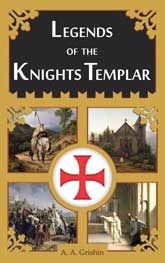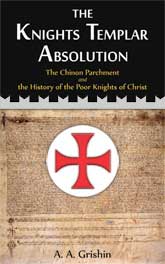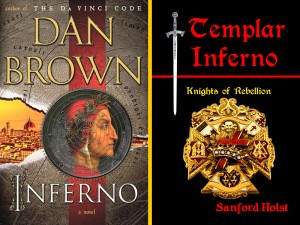 No matter how one views Dan Brown’s novels, his thrillers definitely add some excitement to the life of any rank and file Knights Templar researcher. If there is one thing that The Da Vinci Code proved conclusively, it’s the fact that the Templars have something to do with everything. It is no surprise that the need for expertly written companion volumes (unofficial, of course) that help uninitiated readers get the most out of Dan Brown’s books has been met by Michael Haag, the author of two books on the Knights Templar (The Templars. History and the Myth and The Tragedy of the Templars). Michael wrote a very successful companion to The Lost Symbol and is currently working on a book that will sort out the esoteric underpinnings of Inferno, the latest Robert Langdon novel to date (unpublished at the time of writing). When I noticed that Amazon already carries a book by Sanford Holst, entitled Templar Inferno, which purportedly fills the same niche, my first reaction was that Michael must have already purchased a copy and would be able to honestly say whether the book was worth the money or not. Turned out that he was aware of this work, but has not purchased it… Then curiosity got the better of him, and a few days later Michael reported the following:
No matter how one views Dan Brown’s novels, his thrillers definitely add some excitement to the life of any rank and file Knights Templar researcher. If there is one thing that The Da Vinci Code proved conclusively, it’s the fact that the Templars have something to do with everything. It is no surprise that the need for expertly written companion volumes (unofficial, of course) that help uninitiated readers get the most out of Dan Brown’s books has been met by Michael Haag, the author of two books on the Knights Templar (The Templars. History and the Myth and The Tragedy of the Templars). Michael wrote a very successful companion to The Lost Symbol and is currently working on a book that will sort out the esoteric underpinnings of Inferno, the latest Robert Langdon novel to date (unpublished at the time of writing). When I noticed that Amazon already carries a book by Sanford Holst, entitled Templar Inferno, which purportedly fills the same niche, my first reaction was that Michael must have already purchased a copy and would be able to honestly say whether the book was worth the money or not. Turned out that he was aware of this work, but has not purchased it… Then curiosity got the better of him, and a few days later Michael reported the following:
I now have the book. It is clearly a book written some time ago, the standard Templar fare with a two-page foreword tacked on called Dan Brown’s Inferno, about which Holst says it will be all about the Templars, because Dante wrote Inferno, which is about people burning, as he was inspired by Templars burning all round him. For this two page nonsensical foreword Holst has managed to get a lot of publicity and sell quite a few books.
May it be known, that parts of Michael’s reaction were omitted at his request, although personally I did not feel that he spoke too harshly. From what I have seen of the book, it is not all that well written. The author struggles with basic facts about the Knights Templar, while making claims that need a lot more support to be considered plausible. Not recommended!
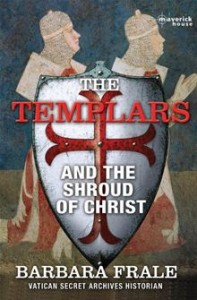 A concise and informative introduction to the Knights Templar / Shroud of Turin connection. Barbara Frale summarizes a great deal of modern research, in particular Ian Wilson’s The Turin Shroud: The Burial Cloth of Jesus Christ?
A concise and informative introduction to the Knights Templar / Shroud of Turin connection. Barbara Frale summarizes a great deal of modern research, in particular Ian Wilson’s The Turin Shroud: The Burial Cloth of Jesus Christ?
After the sack of Constantinople in 1204 a great number of relics which had been previously stored in the imperial capital were either lost or transferred to the West. One of the focal points of Byzantine Christianity, the so called Mandylion, could no longer be accounted for. This relic was believed to have been a towel bearing the image of Christ – not a painted portrait, but instead the Savior’s image that became miraculously imprinted when Jesus held the towel up to his face. Barbara Frale maintains that the Mandylion was actually a folded piece of cloth with a full body image, now known as the Shroud of Turin. At some point during the 13th century this object came into the possession of the Knights Templar, who used it in their religious ceremonies. Fully understanding the value of the shroud, the Order was reluctant to disclose it to the Pope and the church in general. The secrecy that surrounded this object partially explains some of the strange confessions made by the Knights Templar during their trials, including accounts of Baphomet, the mysterious idol that was presumably worshiped by the Order. [click to continue…]
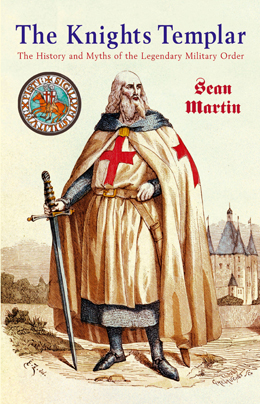 To avoid any confusion, be advised that this review deals exclusively with the audio version of Sean Martin’s “The Knights Templar: The History and Myths of the Legendary Military Order,” as narrated by James Jordan. The book itself is a solid piece of scholarship on par with many other works published on the topic. However, this is quite possibly the only non-fiction “Templar” title available to those of us who rely on audio recordings to stay abreast with the book market.
To avoid any confusion, be advised that this review deals exclusively with the audio version of Sean Martin’s “The Knights Templar: The History and Myths of the Legendary Military Order,” as narrated by James Jordan. The book itself is a solid piece of scholarship on par with many other works published on the topic. However, this is quite possibly the only non-fiction “Templar” title available to those of us who rely on audio recordings to stay abreast with the book market.
The narrator’s voice is suitably professorial, but it did not take too long to spot some problems. For instance, how would you pronounce Urban II? “Urban the First,” right? James Jordan’s preferred way of reading the name of the pope who inspired the Crusades is “Urban Two.” Several similar instances can be found throughout the recording. Numerous other mishaps show up in other proper names: “Jacques” rhymes with “shucks,” the “ch” in “Theoderich” is pronounced as “ch” in “rich,” and the first sillable in “Outremer” is is the same as in the word “out” – with one exception. The phrase “Franks in Outremer” sounds like “Frank Sinatra mare.” It is obvious that the narrator unfortunately does not have any knowledge of neither French nor German, and there was no supervising editor capable of correcting him. In fact, on more than one occasion there seems to be no editorial input whatsoever, when the narrator begins a sentence, aborts it and then reads it again! Shouldn’t such errors be fixed in post-production?
I got the book for free when I signed up for Audible.com, but I cannot honestly recommend it to anyone as a “good listen.” Just too much of a discrepancy between the solid scholarly content and James Jordan’s uneducated narration.
For a paperback version, check out:
“The Knights Templar: The History and Myths of the Legendary Military Order.”
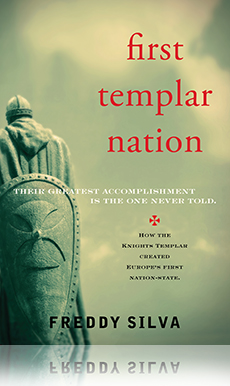 From the Freddy Silva’s new book ‘First Templar Nation: How the Knights Templar created Europe’s first nation-state’ (i.e. Portugal – KTV):
From the Freddy Silva’s new book ‘First Templar Nation: How the Knights Templar created Europe’s first nation-state’ (i.e. Portugal – KTV):
The Templars’ Greatest Accomplishment: The One Story Never Told.
“On Easter Sunday 1118 a new king of Jerusalem was chosen, Baudoin de Bourcq, cousin of the late king Godefroi de Bouillon. Like his former family members, he too had served on the First Crusade. Barely had Baudoin II gotten used to his newly appointed seat when he received a visit from Hugues de Payen and Godefroi de Saint-Omer, as though the two intrepid knights were presenting their credentials.
They may have received a less enthusiastic reception than from his predecessor, for Baudoin II was in desperate need of warrior knights above spiritual warriors. Nevertheless, whatever Hugues and Godefroi pitched the new king it sold him, and shortly after, a small, close-knit group of knights moved into premises on Temple Mount to became officially known as the Knights Templar. But what if it could be shown that seven years earlier the Templars were already present and materially active in another land two thousand miles to the west, and through their intervention, it became their greatest accomplishment — the creation of Europe’s first independent nation-state?”
READ THE ENTIRE ARTICLE
Buy the entire book here.
 No matter how one views Dan Brown’s novels, his thrillers definitely add some excitement to the life of any rank and file Knights Templar researcher. If there is one thing that The Da Vinci Code proved conclusively, it’s the fact that the Templars have something to do with everything. It is no surprise that the need for expertly written companion volumes (unofficial, of course) that help uninitiated readers get the most out of Dan Brown’s books has been met by Michael Haag, the author of two books on the Knights Templar (The Templars. History and the Myth and The Tragedy of the Templars). Michael wrote a very successful companion to The Lost Symbol and is currently working on a book that will sort out the esoteric underpinnings of Inferno, the latest Robert Langdon novel to date (unpublished at the time of writing). When I noticed that Amazon already carries a book by Sanford Holst, entitled Templar Inferno, which purportedly fills the same niche, my first reaction was that Michael must have already purchased a copy and would be able to honestly say whether the book was worth the money or not. Turned out that he was aware of this work, but has not purchased it… Then curiosity got the better of him, and a few days later Michael reported the following:
No matter how one views Dan Brown’s novels, his thrillers definitely add some excitement to the life of any rank and file Knights Templar researcher. If there is one thing that The Da Vinci Code proved conclusively, it’s the fact that the Templars have something to do with everything. It is no surprise that the need for expertly written companion volumes (unofficial, of course) that help uninitiated readers get the most out of Dan Brown’s books has been met by Michael Haag, the author of two books on the Knights Templar (The Templars. History and the Myth and The Tragedy of the Templars). Michael wrote a very successful companion to The Lost Symbol and is currently working on a book that will sort out the esoteric underpinnings of Inferno, the latest Robert Langdon novel to date (unpublished at the time of writing). When I noticed that Amazon already carries a book by Sanford Holst, entitled Templar Inferno, which purportedly fills the same niche, my first reaction was that Michael must have already purchased a copy and would be able to honestly say whether the book was worth the money or not. Turned out that he was aware of this work, but has not purchased it… Then curiosity got the better of him, and a few days later Michael reported the following:


